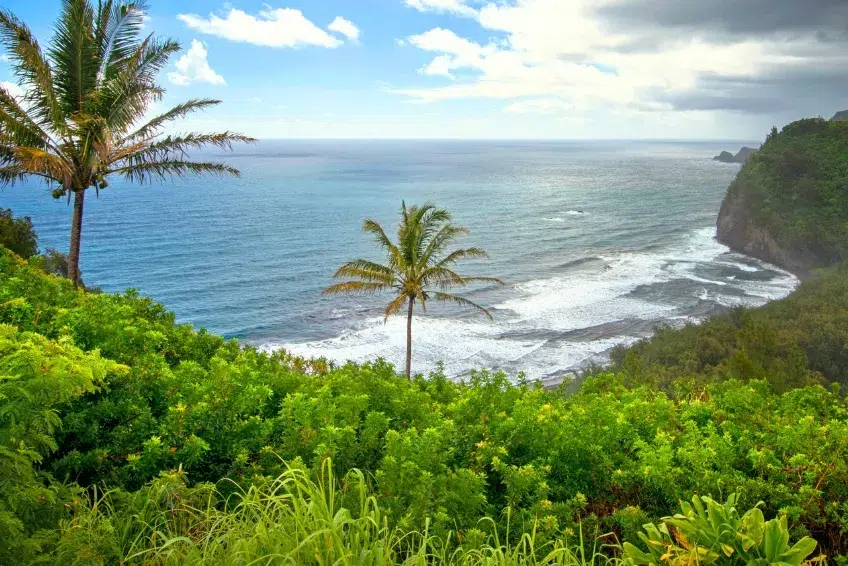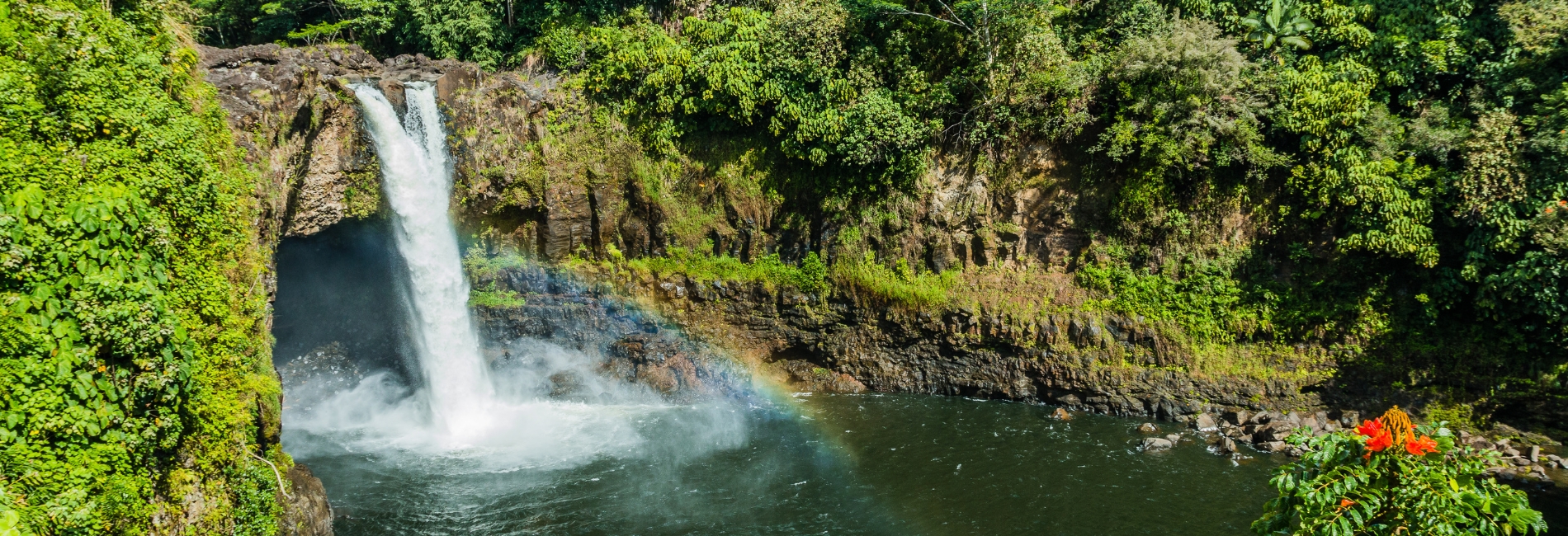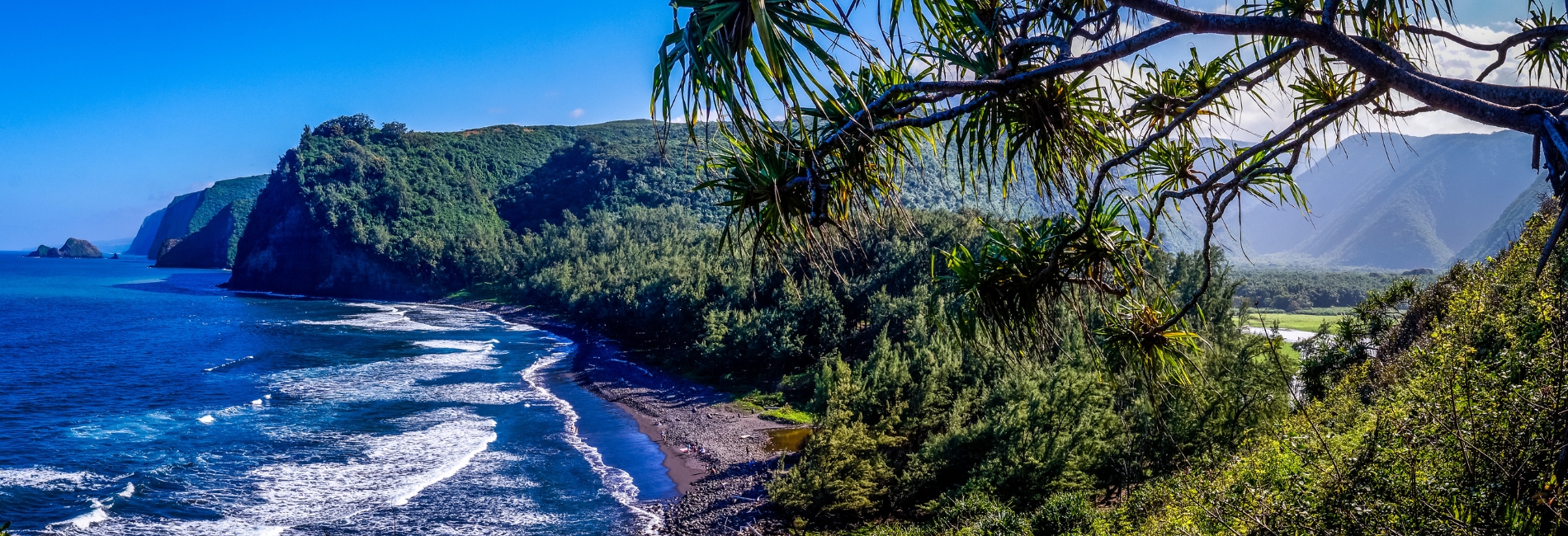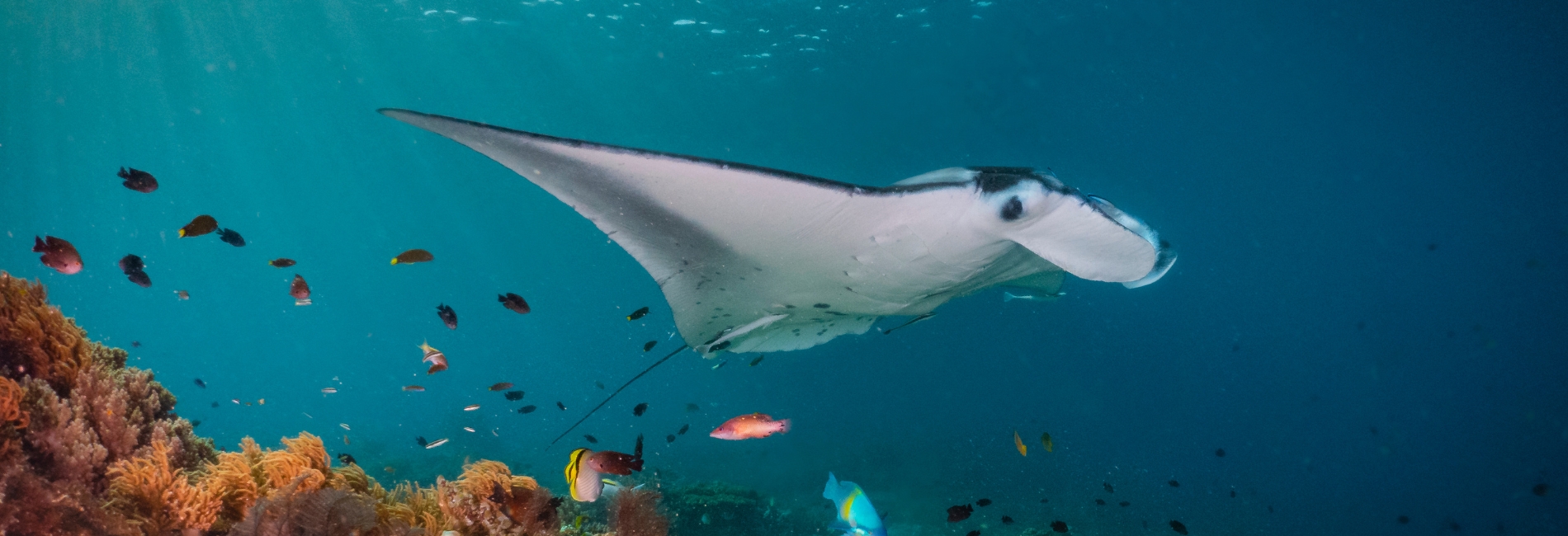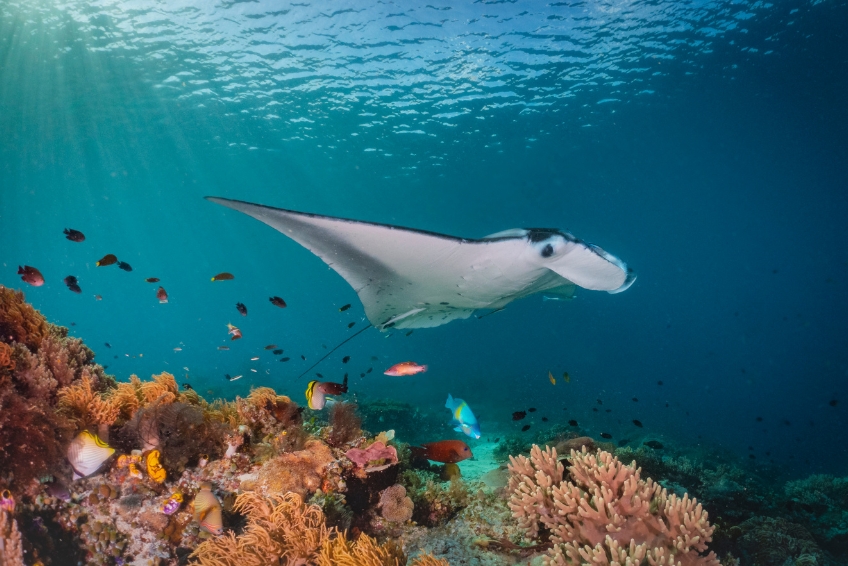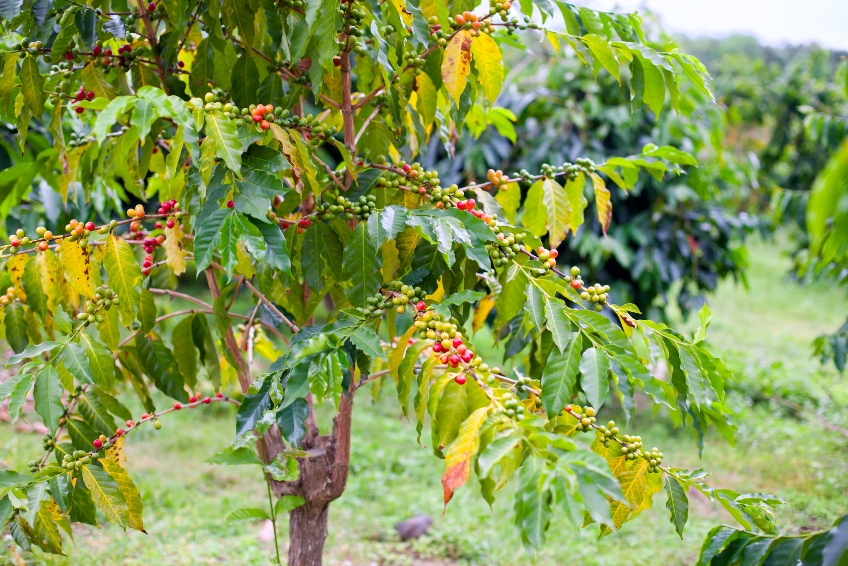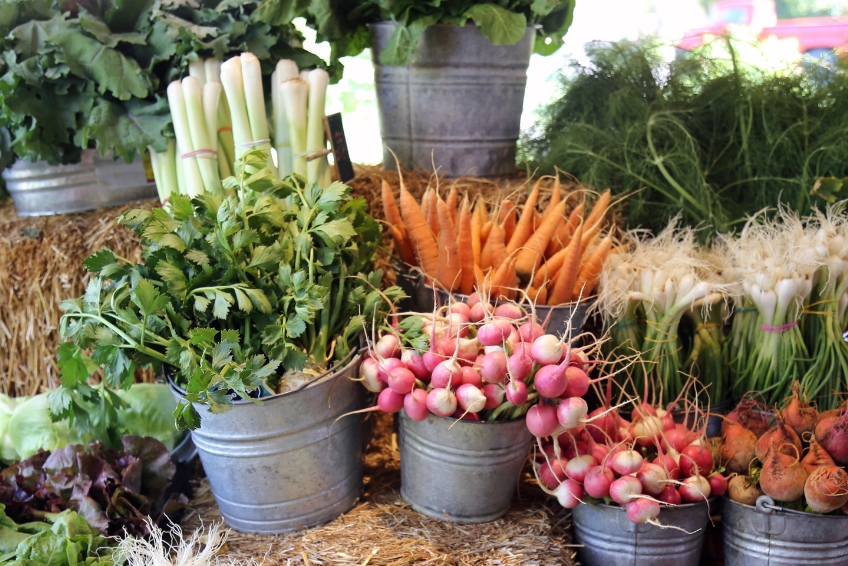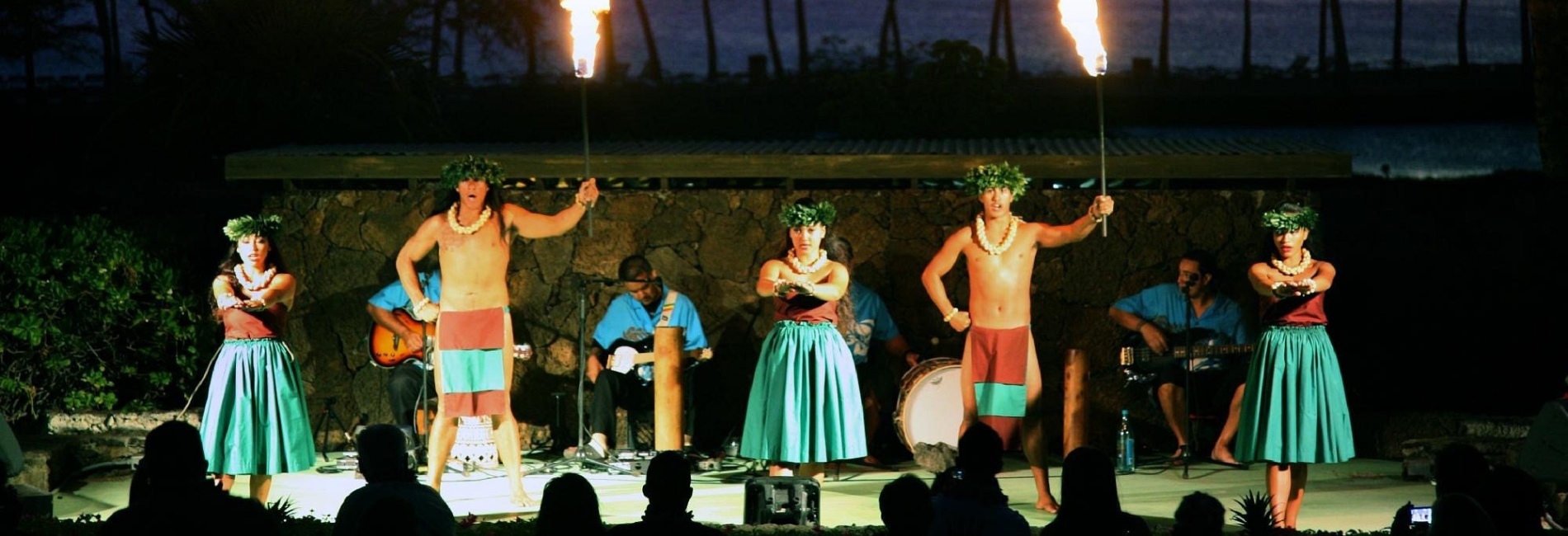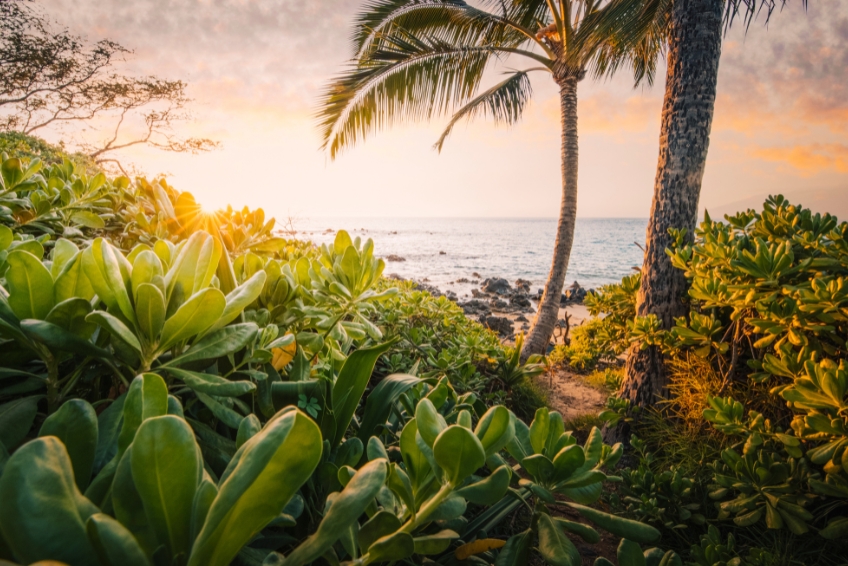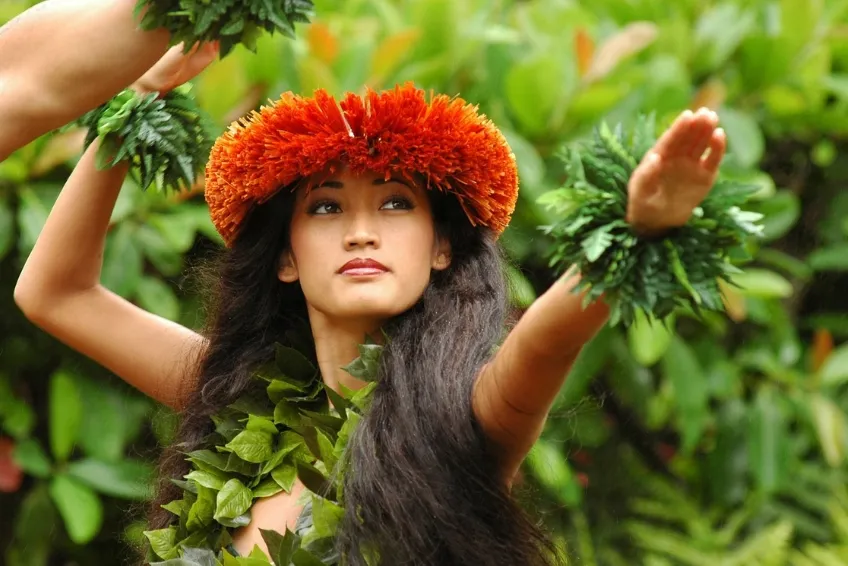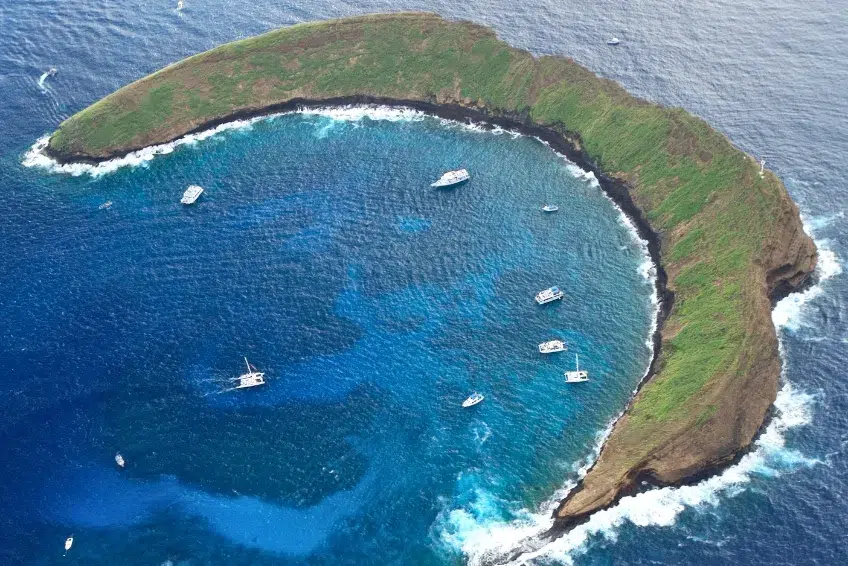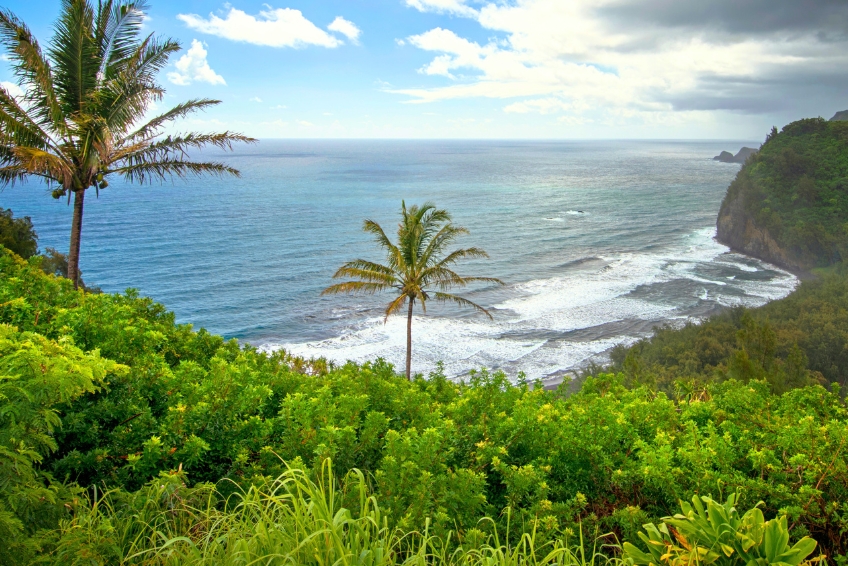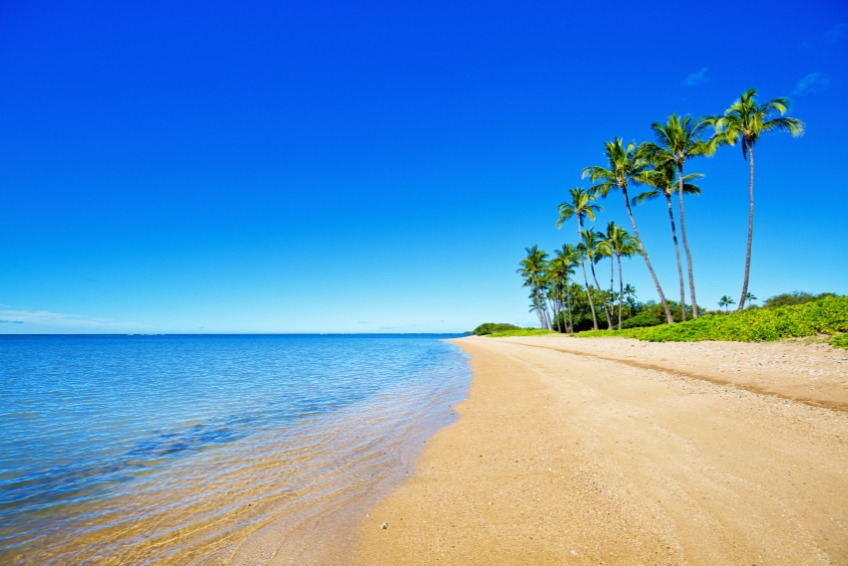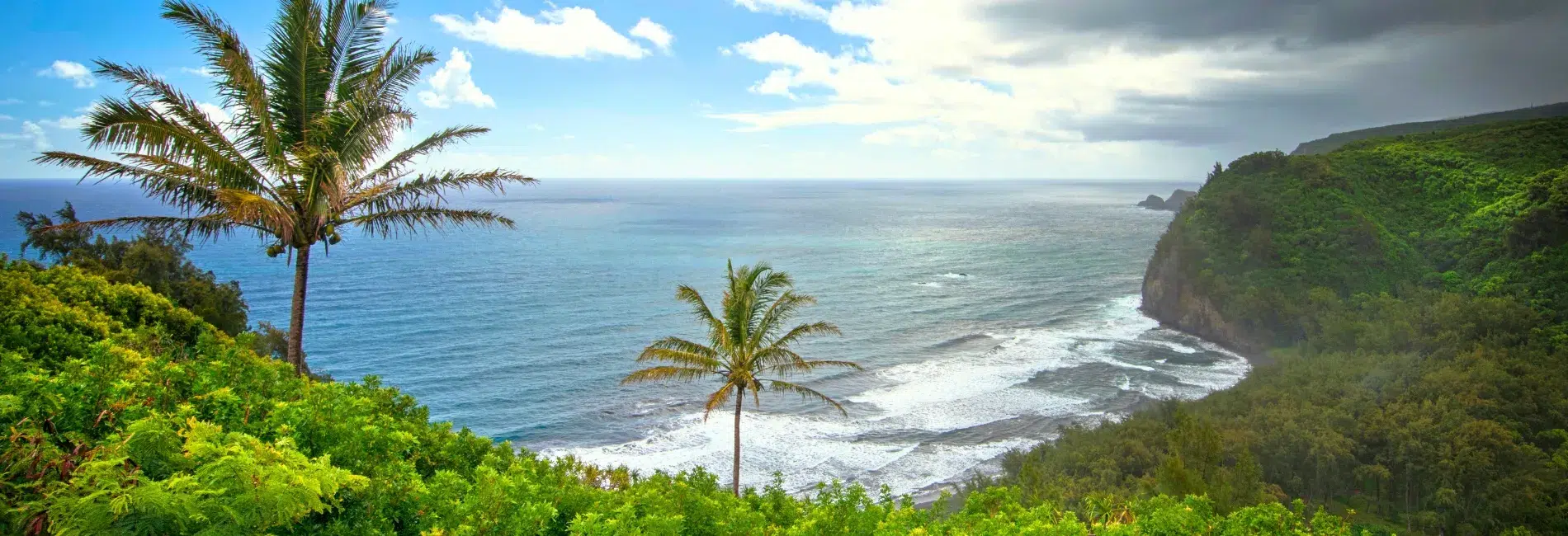
Big Island Of Hawaii Visitors Guide
The Island of Hawaii (Big Island), being both the largest and the youngest of the Hawaiian Islands, presents an incredible range of climates and breathtaking landscapes. You can witness the verdant valley of Hilo, the geological wonders at Hawaiʻi Volcanoes National Park, the snow-covered peaks of Maunakea Mountain and the awe-inspiring jet black sands of Punaluʻu Beach. To best explore this massive island’s abundant and varied beauty, check out our guide below to the best of the Big Island of Hawaii.
This article contains affiliate links. If you click on our links, we may earn a small commission at no extra cost to you. This helps us continue to offer free travel guides, but does not influence our recommendations in any way. Thanks for supporting independent travel content.
Contents

A Bit Of History
Hawaii is steeped in mystery and legends, and legend has it that the Island of Hawaii was first discovered by Hawai’iloa, a mythical Hawaiian fisherman and navigator. The island was the first to be discovered by explorers from the Polynesian region of the Marquesas Islands. Western culture was introduced when Captain Cook landed in 1778. After a year, the captain was killed at Kealakekua Bay by tribal warriors. Nevertheless, he opened the door for other travelers, explorers, and missionaries who came to the island in the 1700s and 1800s.
The Island of Hawaii is home to well preserved historic sites, including ancient Hawaiian temples, petroglyphs, museums and two national historical parks.

Island of Hawaii Today
Today the Island of Hawaii is known for its active volcano, Kilauea, located in Hawaii Volcanoes National Park. The last eruption took place in 2018 and made headlines around the world. The volcanoes on the island continue to shape the landscape. The Island of Hawaii is also known for its incredible natural wonders, including waterfalls, sparkling blue waters and pristine beaches.
Where Is the Island of Hawaii?
The Big Island of Hawaii is the southeasternmost of the Hawaiian Islands in the central Pacific Ocean. It is one of the eight main islands of Hawaii and is located to the southeast of the island of Maui. The Island of Hawaii, also known simply as the Big Island, is the largest in the chain of volcanic islands and has 63% of the Hawaiian archipelago’s combined landmass. It is about twice the size of all the other Hawaiian Islands combined. The largest city is Hilo, which is located on the eastern side of the island. However, the main tourist area on the island is located on the western side, particularly in the towns of Kailua-Kona and Waikoloa.
The Island of Hawaii Map
When Is Hawaii Hurricane Season?
The hurricane season for the Big Island of Hawaii, like in the rest of Hawaii, officially runs from June 1 to November 30 each year. However, the peak of the hurricane season in Hawaii is usually from mid-August to early October. While it’s important to be aware of the potential for hurricanes during this time, it’s worth noting that Hawaii is not typically affected by direct hits from hurricanes, as the islands are small targets in a vast ocean and the mountains of Hawaii can disrupt the flow of storm systems. Be sure to check weather reports ahead of time and we always suggest getting travel insurance during these months just in case.

How to Get to the Big Island & Around
Getting to the Big Island of Hawaii is simple, and once you are on the island, travel is a breeze.

Arrival By Air
There are 2 international airports on the Island, Kona International Airport (KOA) and Hilo International Airport (ITO). Chances are that you will fly into Kona, and this unique airport will leave an impression. It’s a small, primarily outdoor airport.
Another way to get to the Island of Hawaii is by flying into Oahu first, then taking a quick 30–40-minute flight to the Big Island.

Rental Car
Renting a car on the Island of Hawaii is easy and highly recommended due to the size of the island. There are rental car agencies close to the inter-island flight terminals at both Kona and Hilo, as well as both cruise ports. Rentals usually range from $38 per day during the off season for a standard car to $76 per day for an SUV during peak season.
Pay attention to the speed limits on the Island of Hawaii as they are relatively low compared to those on the mainland, around 45/55 mph. You’ll want to keep this in mind when traveling around the island as the speed limits are enforced. Even with a rental car, some locations on the Island of Hawaii are challenging to reach. Most rental car agencies forbid you from taking their vehicles to some difficult to reach locations, such as the summit of MaunaKea or the Green Sand Beach.

Hele-On Bus
The public Hele-On bus service is an excellent alternative if you have plenty of time and want to avoid renting a car. This is the most budget-friendly way to get around the Island of Hawaii. Riding the bus typically costs around $2.00 per ride.
These buses will take you to most places on the island, but keep in mind that transit times are long and connections infrequent. The Hele-On bus is meant to accommodate workers to and from work, and consequently, most bus departure times are early in the morning and late in the afternoon.

Cruise
Most major cruise lines sail to the Island of Hawaii, including Royal Caribbean, Carnival, and Princess. These cruise lines often make stops at both the Kona and Hilo ports of call. Hilo, the capital of the Island of Hawaii, is the port where you can see an active volcano in the Hawaii Volcanoes National Park. While Kona is on the west coast of the island and offers an ideal beach and snorkeling spot.

Taxi
Taxis on the Island of Hawaii are available in and around both Kona and Hilo. However, they are one of the most expensive ways to get around the island, so it’s worth exploring alternatives if you can.
Things To Do in Hawaii
Hawaii's Top Highlights
The Island of Hawaii is a tropical dream. Whether you are looking for nature and outdoor adventure or luxury and relaxation, you won’t find the Big Island lacking in things to do.
1. Visit Hawaii Volcanoes National Park
As one of the United States most geologically interesting national parks, Hawaii Volcanoes National Park is home to two active volcanoes, allowing visitors to see the wonder of nature in action. Keep in mind that parts of the park and surrounding areas, including roads, may be closed during periods of volcanic activity.
The park covers a total of 523 square miles, but continues to grow as active lava flows into the ocean and cools into rock. It is home to both the Kilauea Volcano and the Halema’uma’u crater, the legendary home of the Hawaiian goddess of fire, Pele. This active volcano and steaming crater make Crater Rim Road a must drive scenic highway.
You can hike the Devastation Trail, which showcases the landscape left behind after a 1959 eruption from the Iki crater. Or visit the Thurston Lava Tube, a unique place where lava once flowed, cooled, and left a tunnel nearly 500 feet long and 20 feet high.
Check out this award winning Volcanoes, Waterfalls, Sightseeing, and History Tour. Or this Big Island Active Volcano Adventure Tour with lunch.
Sample the best the Big Island has to offer with this Volcanoes National Park + Rainbow Falls Tour.
2. Relax on One of The Insanely Beautiful Beaches
The Island of Hawaii boasts a diverse array of pristine beaches, each with its own unique appeal. If you want to visit a stunning black sand beach, Pololu Valley Beach is a must-visit destination. While swimming may not be ideal, outdoor enthusiasts will relish the abundance of nearby hiking trails.
For an unforgettable beach experience, make your way to Papakolea Green Sand Beach, where you’ll be mesmerized by the beauty of the green sand set against the rugged cliffs. Although the beach is notoriously windy, it provides ideal conditions for windsurfing. Thrill-seekers can also enjoy cliff jumping at a designated section of the beach.
3. Swim With Manta Rays
One of the most unforgettable experiences you can have in Kona is swimming with manta rays. This adventure is widely considered to be one of the most remarkable dives worldwide, with the opportunity to choose between snorkeling and scuba diving options.
You can select from various tour choices, including day, sunset, and night swimming options. Night swimming with manta rays is the most in-demand option, as the manta rays tend to be more active at night. It is essential to note that this is a highly sought-after activity, and tours fill up quickly.
This Night Swim With Manta Rays Tour is a great option, as is this Manta Ray Night Snorkel tour.
ISLAND LIFE TRAVEL TIP : GET TRAVEL INSURANCE
Travel Insurance is a must in our opinion. Standard health insurance likely doesn’t cover you while outside of the country so travel insurance will cover any emergency medical needs as well as trip cancellation, lost or stolen luggage (it happens), flight delays, missed connections and more. You can easily compare the top-rated travel insurance plans here.
4. Star Gaze on Mauna Kea
Home to the Mauna Kea Observatory active research facility, Mauna Kea is the highest mountain in Hawaii. A sharp contrast to the tropical paradise below, the temperatures at the summit are cold. Don’t let that stop you from visiting for unparalleled views of the stars above each night, just make sure to pack a jacket.
The summit and the Visitor Information Station each sit at altitudes of 13,800 feet and 9,200 feet and can only be accessed by 4WD vehicles. This is one of the drives prohibited by many of the rental car companies, so make sure to check their policies before making the trip.
If you don’t want to deal with the rental car hassle, consider taking a tour like this Mauna Kea Summit Sunset and Stars Tour that comes complete with photos that you can pick up in Hilo or Kona.
Another great option is this Best Mauna Kea Summit Tour.
5. Akaka Falls State Park and Kahuna Falls
Akaka Falls State Park, near Hilo, is home to some of the most beautiful waterfalls on the island, including Akaka Falls and Kahuna Falls. As the tallest falls on the island, Akaka’s water free falls over 442 feet. Set in a stunning and lush tropical paradise filled with ferns, orchids, and bamboo, Akaka Falls is a can’t miss destination on the Island of Hawaii.
The trail to the falls is easy and conveniently paved, but it is quite steep and includes sections of steps. This loop trail is less than a half-mile long and leads you past Kahuna falls to the top of Akaka Falls. Keep an eye out for the offshoot of the trail, which leads to a viewing spot perfect for getting photos of Akaka.
If you don’t want to miss any of the stunning beauty while navigating, consider this Big Island Waterfalls Adventure.
6. Explore The Kona Coffee Living History Farm
Chances are you’ve heard of the famous Hawaiian Kona Coffee. The Kona Coffee Living History Farm is the nation’s only living history museum dedicated to traditional coffee farming. The farm is operated by the Kona Historical Society and shows visitors what life was like for coffee growers in the 1920s and 30s.
As a living history museum, you’ll find that costumed interpreters happily converse with you while they go about their daily tasks, from planting and harvesting to cooking. You can explore the grounds yourself by observing the Kona Nightingale (a breed of donkey) and learning about the methods of roasting and grinding the beans. You can also sample and purchase some of their amazing coffee.
To find out a little more about Kona Coffee and the surrounding area, check out this Kona Tour: Coffee Plantation, Kealakekua Bay, Kaloko-Honokohau Park, and Bee Farm.
7. Vist The Waipio Valley Overlook
On the northeastern coast of the Island of Hawaii, about 50 miles north of Hilo, you’ll discover a modern day “Shangri La.” The Waipio Valley seems to be cut off from the outside world completely. It’s a difficult spot to reach due to the steep cliffs.
The valley floor is covered in bananas, papayas, mangoes, avocados, and grapefruit. Colorful orchids, ginger trees and hibiscus decorate the stunningly lush landscape. Where the valley meets the ocean is a long black-sand beach.
Keep in mind this another area that most car rental companies don’t allow their vehicles to be driven, particularly down into the valley. However, you can walk the road. While the trek down to the valley floor is easy, remember you do have to trek back up to the top. This gorgeous scenic drive along the Hamakua Coast is the Hamakua Heritage Corridor, which runs from the town of Hilo to the Waipio Valley Overlook is truly a unique experience.
8. Check Out Pauko Petroglyph Park
Along the Kohala Coast, you’ll find the 223-acre Puakō Petroglyph Archaeological Preserve. The park boasts more than 3,000 ancient petroglyphs (kiʻipōhaku). These lava rock carvings are etched into stones that date back to 1200 AD.
Although the true meanings of the petroglyphs remain unknown, it is believed that these carvings are records of significant events in the lives of the people of the island of Hawaii. The captivating petroglyphs of Puakō feature carvings of humans, canoes, and turtles, among other things.
This fun family activity is great for kids; they can search for petroglyphs and discover what these ancient symbols mean. Be sure to wear good shoes because the site is unpaved. It also goes through a Kiawe Forest, where there are thorns on the ground.
9. Shop at The Hilo Farmers Market
The Hilo Farmers Market has become a local institution, and it operates daily year-round now. Open from 7 am to 3 pm every day, with the busiest market days falling on Wednesday and Saturday. You don’t want to miss this.
Over 200 vendors gather in Hilo’s historic downtown and sell locally grown flowers, produce, handmade crafts, and souvenirs. The Farmers Market also hosts special events, including annual festivals and weekly themes like Hilo Hula Tuesdays and Market Music.
10. Take In A Hawaiian Luau
A luau on the island of Hawaii is the perfect way to experience the community and culture of the Hawaiian Islands. While luaus were hardly traditional in ancient Hawaii, today, they are a quintessential part of any trip to the islands.
Most luaus on the Island of Hawaii occur on the Kona side in Waikoloa, Kailua-Kona or South Kona. The Legends of Hawaii Luau takes place every Sunday, Tuesday, and Friday in Waikoloa. It features hula and fire dancers, a Hawaiian feast, live music, and handcrafted treasures.
The top rated Mauna Kea Luau takes place at the Mauna Kea Beach Hotel every Tuesday and shares Hawaii’s culture through music, food, and family traditions.
Another popular luau on the Island of Hawaii is the Island Breeze Luau hosted by the King Kamehameha Beach Resort. This royal Hawaiian festivity is held on the former estate grounds of Hawaii’s once great ruler, King Kamehameha. It features Polynesian dancers, a Samoan Fire-Knife Dance, as well as arts and crafts demonstrations.
More
HAWAII
Islands, Beaches, Food and More
Kauai Visitors Guide
Kauai, Hawaii, makes a great vacation destination thanks to the lush landscape, magical waterfalls, and delicious food. Use our travel guide to Kauai to plan your perfect tropical getaway on the Garden Isle.
Maui Waterfalls Guide
If you’re looking for magical, accessible, waterfalls, then Maui is the Hawaiian Island for you. From towering windswept falls to turqoise swimming holes, our Maui Waterfalls Guide has the inside tips on visiting Maui's best waterfalls this year.
Big Island Of Hawaii Hotel Guide
Welcome to the ultimate guide for Big Island of Hawaii hotels. In this guide, we’ll take you through some of the best hotels on the Big Island, ranging from opulent beachfront resorts to cozy bed and breakfasts nestled in the lush rainforest.
Kauai Hotels Guide
Kauai is the definition of paradise with its pristine beaches, lush green mountains, wild canyons, and tropical valleys of palms. This Hawaiian island truly has accommodations for every travel style. Here are the best Kauai hotels!
The Best Oahu Luaus
Oahu’s Luau scene is quite diverse; whether you are looking for an amazingly lavish experience in Waikiki, or an authentic and intimate gathering, you will find it in Oahu. Keep reading for our guide to the best luaus on Oahu.
Best Maui Luaus
A Hawaiian luau is a combination of culture and traditions with a mix of dress, dances, storytelling, and feasting that provides an unforgettable experience for everyone. Here are the best Maui Luaus.
Honolulu Visitors Guide
Honolulu is the heartbeat of the island of Oahu, and this vibrant city has it all. This Honolulu Visitors Guide will help you plan the perfect trip and enjoy your time in this Hawaiian paradise.
Maui Snorkeling Guide
If you’re looking for an unforgettable snorkeling adventure, Maui is a can’t miss destination. Our Maui snorkeling guide has everything you need to get the most out of your visit so you can enjoy the best of what this underwater paradise has to offer!
Big Island Of Hawaii Visitors Guide
The Island of Hawaii (the Big Island) is the largest of the Hawaiian Islands and presents an incredible range of activities and breathtaking landscapes. Check out our guide below to the best of the Big Island of Hawaii.
Oahu Waterfalls Guide
Due to tropical rainfall, mountainous landscapes and lush vegetation, it’s easy for visitors to see dozens of Oahu waterfalls throughout the island. Check out our guide below for the best waterfalls in Oahu, Hawaii.
Molokai Visitors Guide
Molokai is for those who want to experience some of the most extensive untouched natural landscapes on the Hawaiian Islands. Keep reading for everything you need to know to plan your trip to the authentic island of Molokai, Hawaii.
Honolulu Restaurant Guide
You are sure to love the local Hawaiian cuisine that Honolulu has to offer, as well as some of the incredibly delicious influences from the East and West. Here is our guide to the best restaurants in Honolulu!

